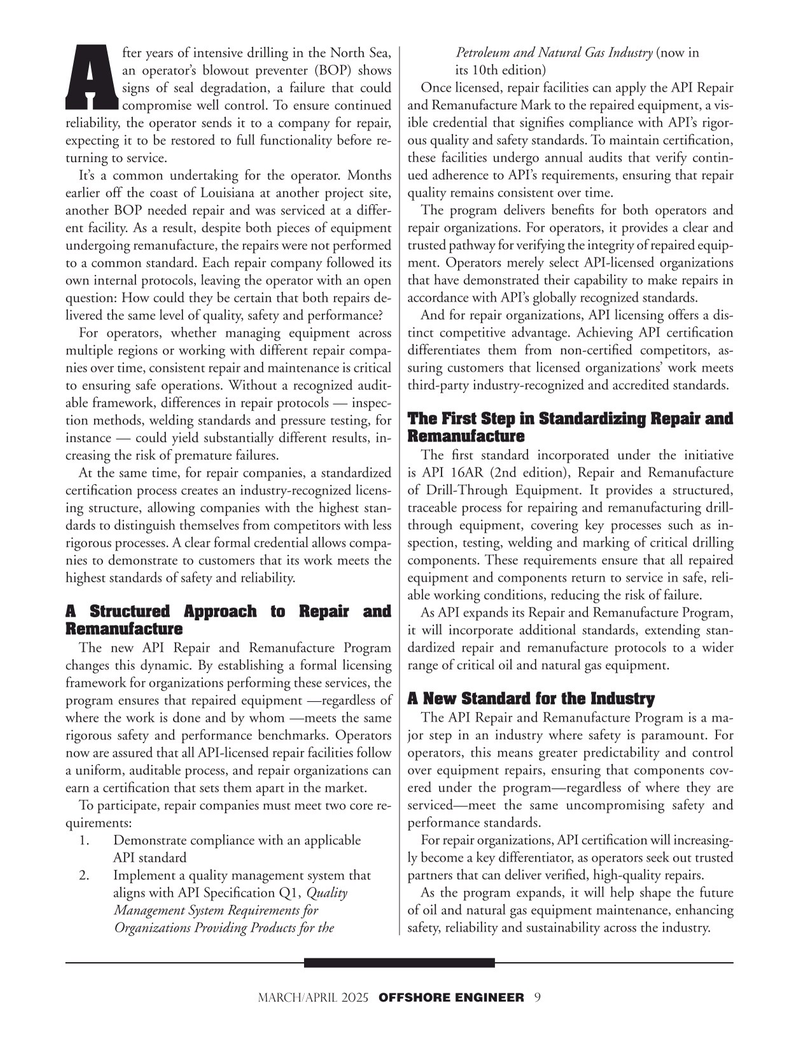
Page 9: of Offshore Engineer Magazine (Mar/Apr 2025)
Read this page in Pdf, Flash or Html5 edition of Mar/Apr 2025 Offshore Engineer Magazine
fter years of intensive drilling in the North Sea, P etroleum and Natural Gas Industry (now in an operator’s blowout preventer (BOP) shows its 10th edition) signs of seal degradation, a failure that could Once licensed, repair facilities can apply the API Repair
A compromise well control. To ensure continued and Remanufacture Mark to the repaired equipment, a vis- reliability, the operator sends it to a company for repair, ible credential that signifes compliance with API’s rigor- expecting it to be restored to full functionality before re- ous quality and safety standards. To maintain certifcation, turning to service. these facilities undergo annual audits that verify contin-
It’s a common undertaking for the operator. Months ued adherence to API’s requirements, ensuring that repair earlier off the coast of Louisiana at another project site, quality remains consistent over time.
another BOP needed repair and was serviced at a differ- The program delivers benefts for both operators and ent facility. As a result, despite both pieces of equipment repair organizations. For operators, it provides a clear and undergoing remanufacture, the repairs were not performed trusted pathway for verifying the integrity of repaired equip- to a common standard. Each repair company followed its ment. Operators merely select API-licensed organizations own internal protocols, leaving the operator with an open that have demonstrated their capability to make repairs in question: How could they be certain that both repairs de- accordance with API’s globally recognized standards. livered the same level of quality, safety and performance? And for repair organizations, API licensing offers a dis-
For operators, whether managing equipment across tinct competitive advantage. Achieving API certifcation multiple regions or working with different repair compa- differentiates them from non-certifed competitors, as- nies over time, consistent repair and maintenance is critical suring customers that licensed organizations’ work meets to ensuring safe operations. Without a recognized audit- third-party industry-recognized and accredited standards. able framework, differences in repair protocols — inspec- tion methods, welding standards and pressure testing, for The First Step in Standardizing Repair and instance — could yield substantially different results, in- Remanufacture creasing the risk of premature failures. The frst standard incorporated under the initiative
At the same time, for repair companies, a standardized is API 16AR (2nd edition), Repair and Remanufacture certifcation process creates an industry-recognized licens- of Drill-Through Equipment. It provides a structured, ing structure, allowing companies with the highest stan- traceable process for repairing and remanufacturing drill- dards to distinguish themselves from competitors with less through equipment, covering key processes such as in- rigorous processes. A clear formal credential allows compa- spection, testing, welding and marking of critical drilling nies to demonstrate to customers that its work meets the components. These requirements ensure that all repaired highest standards of safety and reliability. equipment and components return to service in safe, reli- able working conditions, reducing the risk of failure.
A Structured Approach to Repair and As API expands its Repair and Remanufacture Program,
Remanufacture it will incorporate additional standards, extending stan-
The new API Repair and Remanufacture Program dardized repair and remanufacture protocols to a wider changes this dynamic. By establishing a formal licensing range of critical oil and natural gas equipment. framework for organizations performing these services, the program ensures that repaired equipment —regardless of A New Standard for the Industry where the work is done and by whom —meets the same The API Repair and Remanufacture Program is a ma- rigorous safety and performance benchmarks. Operators jor step in an industry where safety is paramount. For now are assured that all API-licensed repair facilities follow operators, this means greater predictability and control a uniform, auditable process, and repair organizations can over equipment repairs, ensuring that components cov- earn a certifcation that sets them apart in the market. ered under the program—regardless of where they are
To participate, repair companies must meet two core re- serviced—meet the same uncompromising safety and quirements: performance standards.
1. D emonstrate compliance with an applicable For repair organizations, API certifcation will increasing- AP I standard ly become a key differentiator, as operators seek out trusted 2. I mplement a quality management system that partners that can deliver verifed, high-quality repairs.
aligns with API Specifcation Q1, Quality As the program expands, it will help shape the future M anagement System Requirements for of oil and natural gas equipment maintenance, enhancing O rganizations Providing Products for the safety, reliability and sustainability across the industry.
march/april 2025 OFFSHORE ENGINEER 9

 8
8

 10
10